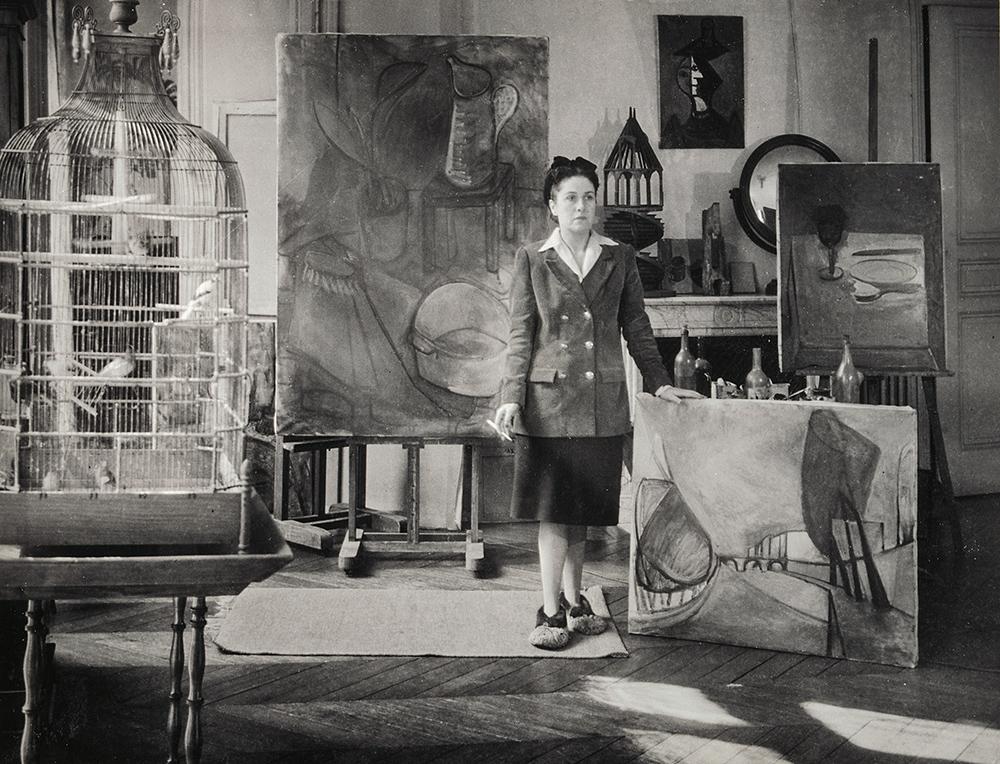Beautiful, feisty, and fiercely independent, Francoise Gilot went from Picasso's muse to master.
Here is an article from Gallery M so you can get to know her and love her as much as we do.
After 60 years as an artist, Francoise Gilot continues to conquer canvas with her own language of form and color. Her work, done in a variety of media, holds a vital place in the international art world. Gilot is included in the permanent collections of the Musee Picasso in Antibes, the Museum of Modern Art in New York, Musee de Tel Aviv in Israel, the Women's Museum in Washington D.C. and Bibliotheque Nationale and Musee d'art Moderne in Paris. In 1990, she received the Chevalier de la Legion d'Honneur, the French government's highest honor, for her work as a painter, writer and feminist.

Francoise Gilot pictured with Pablo Picasso.
Born in 1921 in Neuilly-sur-Seine, Gilot, at age 5 declared that she would become a painter. Her mother tutored her with watercolor and India ink. Formal studies began in 1934, and, over the objections of her father who envisioned a career in law or science; she pursued her interest in art. Her first exhibit was held during the Nazi occupation of Paris. Sadly, her earliest drawings and watercolors were lost in a German bombing raid.

Gilot stands in front of her own artwork, 1977.
TORONTO STAR VIA GETTY IMAGES
Gilot's career took off in the late 1950s when she broke away from Picasso's influence to develop a more personal style. This phase of her work was said to have created a bridge between the School of Paris of the 1940s and '50s and the contemporary American art scene. Gilot began to explore works on paper and the intricate layers of gouache. In the 1960s, she traveled to the United States to exhibit her art.
 Study for self-portrait in orange with blue necklace , 1944–1945, Françoise Gilot
Study for self-portrait in orange with blue necklace , 1944–1945, Françoise Gilot
artnet.com
With a degree in philosophy from the University of Paris and another in English Literature from Cambridge University, Gilot became an accomplished writer and poet. She authored and illustrated several books including Life with Picasso written with Carlton Lake (1964), The Fugitive Eye (1976, Interface: the Painter and the Mask (1983), Francoise Gilot: An Artists Journey (1987) and Matisse and Picasso: A Friendship in Art (1990). While living with Picasso, Gilot had two children, Claude and Paloma. Later, she married Luc Simon and had a second daughter Aurelia. Her children appear as the subjects of many of her paintings. Other themes include birds, emblems, Buddhist and Hopi symbols, Greek mythology and "floating" spaces. Gilot's childhood in France and travels to Greece and the Orient are also subjects of many of her works.Later in life, Gilot married Dr. Jonas Salk, developer of the polio vaccine. Now in her early eighties, she continues to paint at studios in both Paris and New York.
Biography from Gallery M, read more here:
https://www.gallerym.com/pages/francoise-gilot-biography
TIMELINE
1921 Born Neuilly-sur-seine, France
1938 Bachelor of Arts (Philosophy), University of Paris, France
1939 Degree in English Literature, Cambridge University
1939–1942 Studied Law and Literature, Paris, France
1943–1945 Academy Julian, Paris
1943–1945 L’Ecole des Beaux Arts, Paris
1978 Officier dans l’Ordre des Arts et Lettres, Minister of Culture, Paris, France
1982 Doctorate of Fine Arts, Honoris Causa, Hofstra University, New York
1988 Commandeur dans l’Ordre des Arts et Lettres, Minister of Culture, Paris, France
1990 Chevalier de la Légion d’Honneur, Minister of Culture, Paris, France
1996 Officier de l’Ordre National du Mérite, President of the Republic, Paris, France
Timeline from artnet, read more here:

